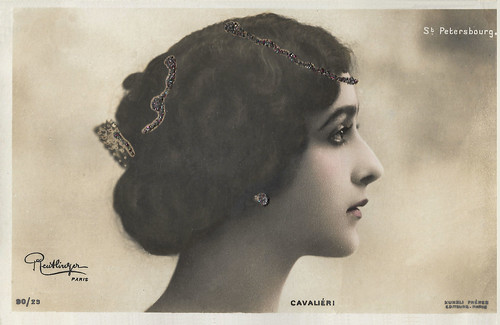
French postcard by Kunzli Frères Editeurs, Paris, series 30/29. Photo: Reutlinger, Paris. Caption: St. Petersbourg.
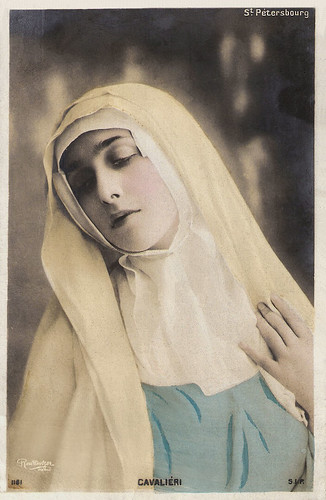
French postcard by S.I.P, no. 1181. Photo: Reutlinger, Paris. Caption: St. Petersbourg. Lina Cavalieri in the opera 'Thaïs' by Jules Massenet.

French postcard by S.I.D., no. 1188. Photo: Reutlinger. Sent by mail in 1907. Lina Cavallieri in the opera 'Thaïs' by Jules Massenet. The work was first performed in Italy at the Teatro Lirico Internazionale in Milan on 17 October 1903 with Lina Cavalieri in the title role and Francesco Maria Bonini as Athanaël.
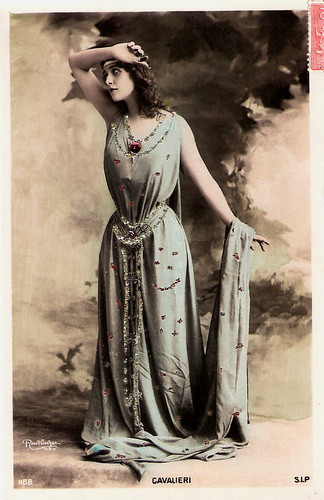
French postcard by S.I.P., no. 1188. Sent by mail in 1906. Photo: Reutlinger, Paris. Lina Cavalieri in the opera 'Thaïs' by Jules Massenet.

French postcard by S.I.P., no. 1188. Sent by mail in 1905. Photo: Reutlinger, Paris.
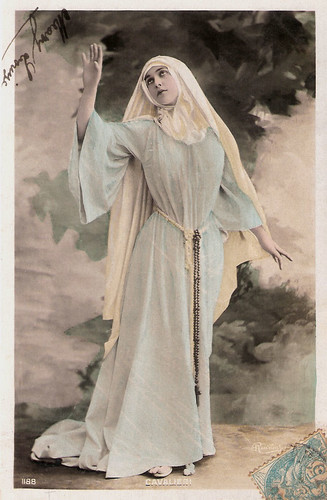
French postcard, no. 1188. Sent by mail in 1906. Photo: Reutlinger, Paris. Lina Cavallieri in the opera 'Thaïs' by Jules Massenet.
Hour-glass figure
Lina Cavalieri was born Natalina Cavalieri into poverty in a slum in Viterbo, Italy, in 1875. She first sold flowers on the streets of Rome, then packed copies of one of the local newspapers. At the age of thirteen she made her first appearances in a café chantant in Rome's Piazza Navona, where, after her performances, she took around a hat for donations.
She lost her parents at the age of fifteen and became a ward of the state, sent to live in a Roman Catholic orphanage. Unhappy under the strict raising of the nuns, she ran from the orphanage with a theatre group. Blessed with a good singing voice and stunning good looks, she made a career as a vaudeville singer.
At the Folies Bergère in Paris, she came to rank with Cécile Sorel and Caroline Otero as one of the queens of the Belle Époque, and the management quickly renewed her contact. In 1897 she triumphed at London's Empire Theatre, and later also in St. Petersburg. In 1900, she made her opera debut in Lisbon, Portugal, as Nedda in 'Pagliacci'. That same year she married her first husband, the Russian Prince Alexandre Bariatinsky. In 1904, she sang at the Opéra de Monte-Carlo.
A year later, Cavalieri starred opposite Enrico Caruso in 'Fedora' at the Sarah Bernhardt Theatre in Paris. From there, she and Caruso took the opera to New York City, debuting it at the Metropolitan Opera on 5 December 1906. According to IMDb, Cavalieri became so carried away with Caruso that she once kissed him passionately on stage. Cavalieri remained with the Metropolitan Opera for the next two seasons, performing again with Caruso in 1907, in Puccini's 'Manon Lescaut'.
She became one of the most photographed stars of her time, and was frequently referred to as the 'world's most beautiful woman'. Cavalieri was famous for her hourglass figure, visible in photographs and portraits by Cesare Tallone, Giovanni Boldini and Reutlinger. During the 1909–1910 season she sang with Oscar Hammerstein's Manhattan Opera Company. Her first marriage long over, she had a whirlwind romance and marriage with Robert Winthrop Chanler, a member of New York's prominent Astor family. However, this marriage lasted only a very short time
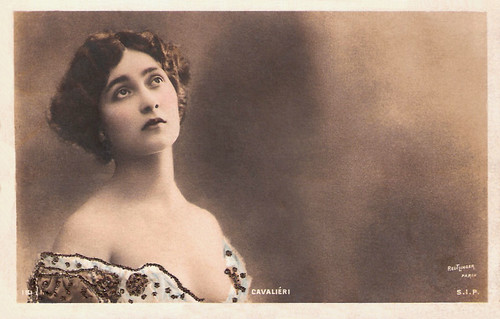
French postcard by S.I.P., no. 180/1. Photo: Reutlinger, Paris.

French postcard by S.I.P., 50th series, no. 4. Sent by mail in 1908. Photo: Reutlinger, Paris.
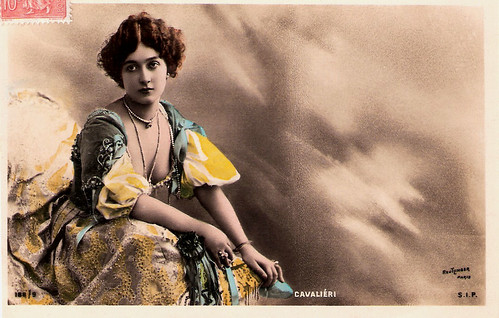
French postcard by S.I.P., no. 188/9. Sent by mail in 1906. Photo: Reutlinger, Paris.

French postcard by S.I.P., 50th series [?]. Photo: Reutlinger, Paris. Signed 30 January 1906.

French postcard by SID, no. 910/5. Sent by mail in 1905. Photo: Reutlinger, Paris.

French postcard by S.I.P., series 30, no. 2. Photo: Reutlinger, Paris.
Presumed lost
Back in Europe, Lina Cavalieri married French tenor Lucien Muratore in 1913. She withdrew from the stage and started a career in the cinema. In Great Britain, she appeared in Manon Lescaut (Herbert Hall Winslow, 1914) opposite her husband. It was the first feature-length (four reels) adaptation of Abbe Prevosts tragic novel 'Manon Lescaut'.From 1915 on, she appeared in Italy in the films La sposa della morte/The Bride of Death (1915) and La rosa di Granada/The Rose of Granada (1916), both directed by Emilio Ghione.
She returned to the United States, where she appeared in the melodrama The Eternal Tempress (Emile Chautard, 1917), Love's Conquest (Edward José, 1918), A Woman of Impulse (Edward José, 1918), and The Two Brides (Edward José, 1919) for Famous Players-Lasky. In these films, Cavalieri was already in her forties. Hans J. Wollstein commented at AllMovie: "Unlike (opera diva Geraldine) Farrar, Cavalieri proved rather too theatrical for what really was an intimate medium."
Most of her films are presumed lost now, but her recorded voice remains. La Cavalieri's discography is slim though. In 1910, for Columbia, she recorded famous arias, as well as the song, 'Maria, Marì!' In 1917, for Pathé, the soprano recorded 'Le rêve passé' (The Dream Passed), with Lucien Muratore.
Married for the fourth time to Paolo d’Arvanni, Cavalieri returned to live with her husband in Italy. During the Second World War, she worked as a volunteer nurse. In 1944, she was killed in an Allied bombing raid which destroyed her home near Florence.
Lina Cavalieri was immortalised in an Italian biopic dedicated to her life: La donna più bella del mondo/The Most Beautiful Woman in the World (1955) starring Gina Lollobrigida. In 2004, a book was published, 'Lina Cavalieri: The Life of Opera’s Greatest Beauty, 1874–1944', written by Paul Fryer and Olga Usova.
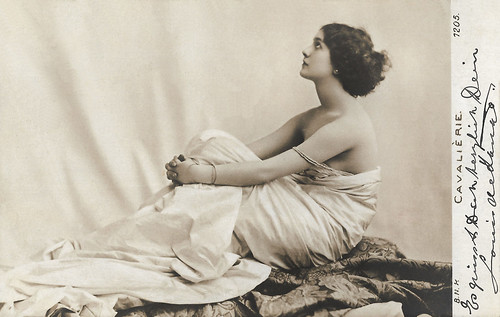
French-Russian postcard by B.N.K., no. 7205. Sent by mail in Russia in 1905.

Italian postcard and photo by Alterocca, Terni, no. 1750. Virgilio Alterocca (1853-1910) founded the first company for illustrated and photographic cards in Italy. He already founded a typographic company in 1877 working for newspapers and producing posters, but around 1896, thanks to modernising techniques in phototypography from Germany and Switzerland, he made a booming business with photographic cards.
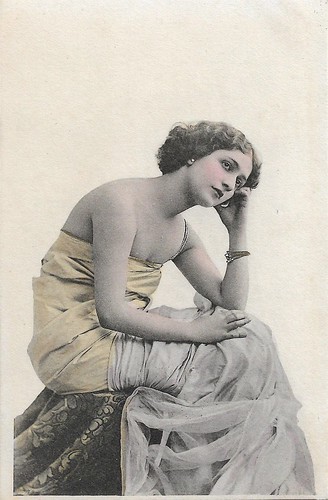
German postcard, Series 81, editor unknown. Almost identical to our b&w Alterocca card with the same photo, but this is a hand-coloured version. Based on a photo by Reutlinger.

French postcard by RPH, Paris, no. 5001. Photo: Reutlinger, Paris.

French postcard by RA, no. 5066. Photo: Reutlinger, Paris.
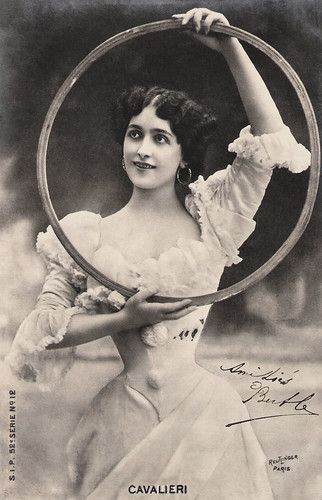
French postcard by S.I.P, series 52, no. 12. Photo: Reutlinger, Paris. Sent by mail in 1902.

French postcard by F.C. & Cie, no. 21. Photo: A. Bert. Signed 22-3-1912.

French postcard by S.I.P. Photo: Reutlinger. Sent by mail in 1905.

French postcard by S.I.P., no. 1461 Photo: Reutlinger. Sent by mail in 1908.
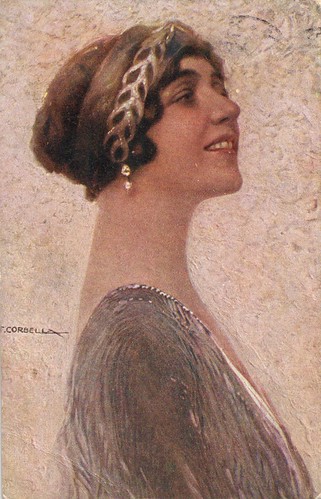
Italian postcard. Lina Cavalieri painted by Tito Corbella, in a kind of Paul Poiret fashion. Corbella painted the portrait after a photo. Uff. Rev. Stampa No. 894, Milano, 25-5-1917.
Hear Lina sing 'Maria, Marì!' (1910). Source: peppopb (YouTube).
Sources: Michael E. Henstock (Opera Quarterly), Hans J. Wollstein (AllMovie), Wikipedia, Terniweb.it and IMDb.
Love absolutely love your site.
ReplyDelete